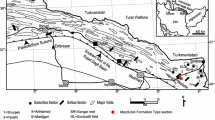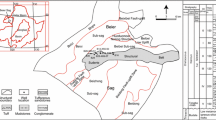Abstract
Miller field of the North Sea has had high concentrations of natural CO2 for ~70 Ma. It is an ideal analog for the long-term fate of CO2 during engineered storage, particularly for formation of carbonate minerals that permanently lock up CO2 in solid form. The Brae Formation reservoir sandstone contains an unusually high quantity of calcite concretions; however, C and O stable isotopic signatures suggest that these are not related to the present-day CO2 charge. Margins of the concretions are corroded, probably because of reduced pH due to CO2 influx. Dispersed calcite cements are also present, some of which postdate the CO2 charge and, therefore, are the products of mineral trapping. It is calculated that only a minority of the reservoired CO2 in Miller (6–24%) has been sequestrated in carbonates, even after 70 Ma of CO2 emplacement. Most of the CO2 accumulation is dissolved in pore fluids. Therefore, in a reservoir similar to the Brae Formation, engineered CO2 storage must rely on physical retention mechanisms because mineral trapping is both incomplete and slow.






Similar content being viewed by others
References
Baines SJ, Worden RH (2004) The long-term fate of CO2 in the subsurface: natural analogues for CO2 storage. In: Baines SJ, Worden RH (eds) Geological storage of carbon dioxide. Special publication 233. Geological Society, London, pp 59–85
Bethke CM (2006) The Geochemist’s Workbench, version 6.0, a user’s guide to Rxn, Act2, Tact, SpecE8, and Aqplot, hydrogeology program. Oxford University Press, Oxford, 397 pp
Curtis CD (1978) Possible links between sandstone diagenesis and depth related geochemical reactions occurring in enclosing mudstones. J Geol Soc Lond 135:107–117
Enick PM, Klara SM (1990) CO2 solubility in water and brine under reservoir conditions. Chem Eng Commun 90:23–33
Garland CR (1993) Miller field: reservoir stratigraphy and its impact on development. In: Parker JR (ed) Petroleum geology of Northwest Europe: proceedings of 4th conference. Geological Society, London, pp 401–414
Greenwood PJ, Shaw HF, Fallick AE (1994) Petrographic and isotopic evidence for diagenetic processes in middle Jurassic sandstone and mudrocks from the Brae area, North Sea. Clay Miner 29:637–650
Gunter WD, Perkins EH, McCann TJ (1993) Aquifer disposal of CO2-rich greenhouse gases: reaction design for added capacity. Energy Convers Manag 34:941–948
Gunter WD, Wiwchar B, Perkins EH (1997) Aquifer disposal of CO2-rich greenhouse gases: extension of the time scale of experiment for CO2-sequestering reactions by geochemical modelling. Miner Petrol 59:121–140
Hendry JP, Wilkinson M, Fallick AE, Haszeldine RS (2000) Ankerite cementation in deeply buried Jurassic sandstone reservoir of the Central North Sea. J Sediment Res 70:227–239
Irwin H, Curtis C, Coleman M (1977) Isotopic evidence for source of diagenetic carbonates formed during burial of organic-rich sediments. Nature 269:209–213
James AT (1990) Correlation of reservoired gases using the carbon isotopic compositions of wet gas components. AAPG Bull 74:1441–1458
Johnson JW, Nitao JJ (2002) Enhanced caprock integrity and self-sealing of the immiscible plume through mineral trapping during prograde and retrograde CO2 sequestration in saline aquifers. AAPG Bull 86:161–162
Knauss KG, Johnson JW, Steefel CI (2005) Evaluation of the impact of CO2, co-contaminant gas, aqueous fluid and reservoir rock interactions on the geologic sequestration of CO2. Chem Geol 217:339–350
Kohl AL, Nielsen RB (1997) Gas purification. Gulf Publishing Company, Houston
Larter SR, Aplin AC, Bjoroy M, Carpentier B, Chen M, Curtis C, England WA, Espitalie J, Fleet AJ, Goodwin NS (1995) THERMIE reservoir geochemistry project: miller field demonstration. CEC THERMIE Reservoir Geochemistry Project, 44 pp
Lu J, Wilkinson M, Haszeldine RS, Fallick AE (2009) Long-term performance of a mudrock seal in natural CO2 storage. Geology 37:35–38
Macaulay CI, Haszedline RS (1993) Distribution, chemistry, isotopic composition and origin of diagenetic carbonates: magnus sandstone, North Sea. J Sediment Petrol 63:33–43
MacKenzie AS, Price I, Leythaeuser D, Muller P, Radke M, Schaefer RG (1987) The expulsion of petroleum from Kimmeridge Clay source-rocks in the area of the Brae Oilfield, UK continental shelf. In: Brooks J, Glennie K (eds) Petroleum geology of North West Europe. Graham & Trotman, London, pp 865–877
Marchand AME (2001) Diagenesis and porosity preservation in deepwater oilfield sandstones. PhD thesis, The University of Edinburgh, Edinburgh, Scotland, 231 pp
Marchand AME, Haszeldine RS, Smalley PC, Macaulay CI, Fallick AE (2001) Evidence for reduced quartz cementation rates in oil-filled sandstones. Geology 29:915–918
Marchand AME, Macaulay CI, Haszeldine RS, Fallick AE (2002) Pore water evolution in oilfield sandstones: constraints from oxygen isotope microanalysis of quartz cement. Chem Geol 191:285–304
Mclaughlin OM, Haszeldine RS, Fallick AE, Rogers G (1994) The case of the missing clay, aluminum loss and secondary porosity, South Brae Oil-Field, North-Sea. Clay Miner 29:651–663
Rooksby SK (1991) The Miller field, blocks 16/7b, 16/8b UK North Sea. In: Abbotts IL (ed) United Kingdom oil and gas fields, 25 years: commemorative volume. Memoir 14. Geological Society of London, pp 159–164
Scotchman IC (1993) Diagenetic pore fluid evolution in the Kimmeridge Clay Formation: from concretions to sandstone cements. In: Manning DAC, Hall PL, Hughes CR (eds) Geochemist of clay-pore fluid interactions. Chapman and Hall, London, pp 128–159
Smalley PC, Warren EA (1994) The Buchan field. In: Warren EA, Smalley PC (eds) North Sea formation waters atlas. Memoir 15. Geological Society of London, 15 pp
Turner CC, Cohen JM, Connell ER, Cooper DM (1987) A depositional model for the South Brae oilfield. In: Brooks J, Glennie K (eds) Petroleum geology of Northwest Europe. Graham & Trotman, London, pp 853–864
White SP, Allis RG, Moore J, Chidsey T, Morgan C, Gwynn W, Adams M (2005) Simulation of reactive transport of injected CO2 on the Colorado Plateau, Utah. Chem Geol 217:387–405
Wilkinson M, Haszeldine RS, Fallick AE, Odling N, Stoker SJ, Gatliff RW (2009) CO2-mineral reaction in a natural analogue for CO2 storage—implications for modeling. J Sediment Res 79:486–494
Xu T, Apps JA, Pruess K (2003) Reactive geochemical transport simulation to study mineral trapping for CO2 disposal in deep arenaceous formations. J Geophys Res B Solid Earth 108:3–13
Xu T, Apps JA, Pruess K (2005) Mineral sequestration of carbon dioxide in a sandstone–shale system. Chem Geol 217:295–318
Zerai B, Saylor BZ, Matisoff G (2006) Computer simulation of CO2 trapped through mineral precipitation in the Rose Run Sandstone, Ohio. Appl Geochem 21:23–240
Acknowledgments
Rock samples were supplied by the British Geological Survey Core Store in Edinburgh. JL is funded by a Dorothy Hodgkin Postgraduate Award (NERC); MW is funded by the UK Energy Research Centre; RSH is funded by the Scottish Centre for Carbon Storage; SUERC is funded by NERC and Scottish Universities Consortium. Publication authorized by the Director, Bureau of Economic Geology.
Author information
Authors and Affiliations
Corresponding author
Rights and permissions
About this article
Cite this article
Lu, J., Wilkinson, M., Haszeldine, R.S. et al. Carbonate cements in Miller field of the UK North Sea: a natural analog for mineral trapping in CO2 geological storage. Environ Earth Sci 62, 507–517 (2011). https://doi.org/10.1007/s12665-010-0543-1
Received:
Accepted:
Published:
Issue Date:
DOI: https://doi.org/10.1007/s12665-010-0543-1




